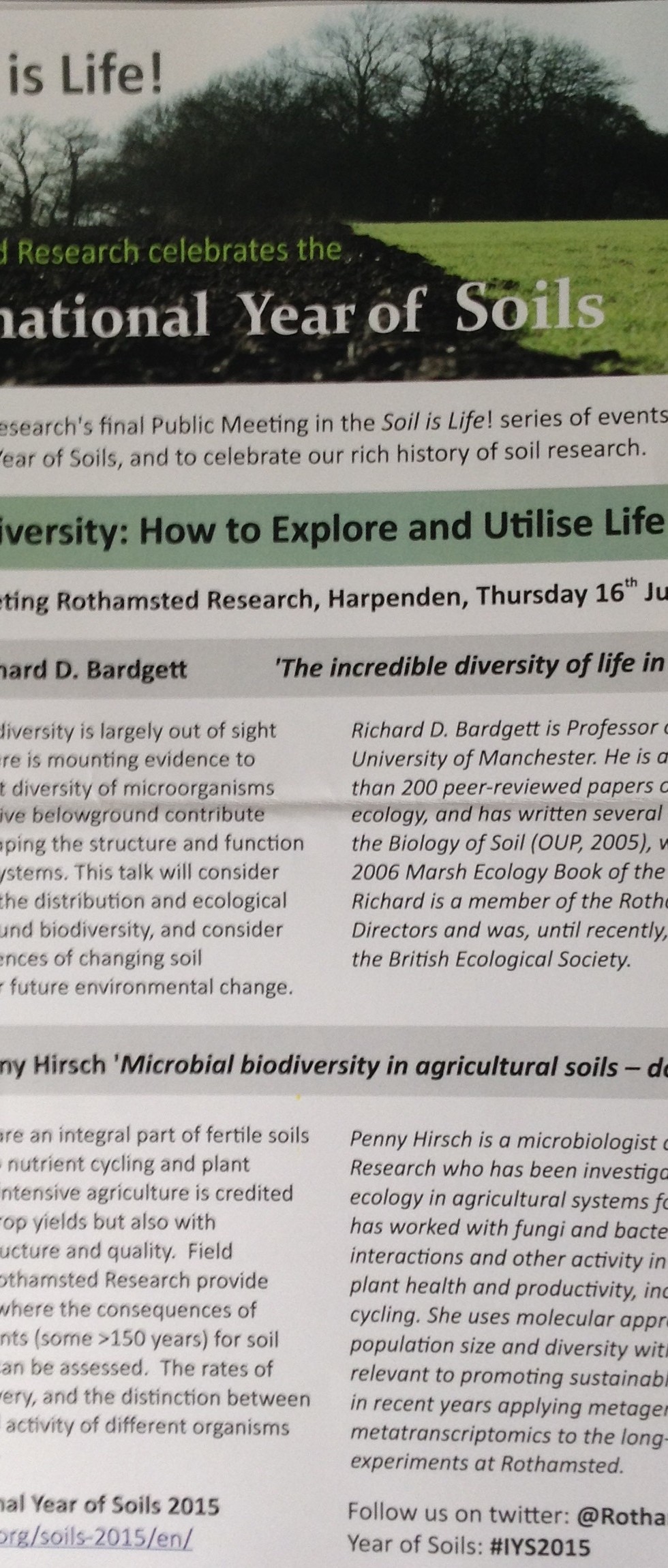More soil life, more plant life; more plant life, more soil life…
‘Soil is Life!‘ was the name of the public open day at Rothamsted Research back on 17 May, and I was one of the visitors.
Last week, on 16 July, I went to yet another event in Rothamsted’s contribution to the International Year of Soils.
This time – like the Wildlife Gardening Forum’s conference in June – the focus was on the wildlife in the soil.
There were two speakers, Richard D. Bardgett and Penny Hirsch, and their talks were complementary: the (relatively) big stuff, soil animals and fungi, and the small stuff, bacteria, both natural and agricultural soils, and soils in Britain and abroad. I hope that their presentations will become available on the Rothamsted website because they were full of fascinating details and references, and I didn’t manage to make notes of all of it. There was a fair bit of time for questions and discussion at the end – I’ve got notes of 13 questions – but what they both had to share with us was so fascinating we could have had a discussion that lasted all day and all night.
So here are a few of the things I found most interesting.
Richard Bardgett works mostly on soil in natural systems and in different countries around the world. He talked about research by Maria Tsiafouli and others, who found that intensive agriculture reduces soil biodiversity across Europe, in the United Kindom, Sweden, Czechoslovakia and Greece. The same pattern repeated itself in all four countries: as intensification increased, there were fewer species and fewer types of species. Franciska de Vries and others found that reduced soil biomass and biodiversity meant more carbon and nitrogen lost from the land. One important finding is that more complex soil communities are better able to withstand and to recover from environmental change – they can act as buffers.
Penny Hirsch talked about the work of her group at Rothamsted, mostly on bacteria in agricultural soils, and how cultivation, fertilisers, livestock, and harvesting all affect soil biodiversity. She started with a photo of a perfume that smells of wet soil (it’s from the United States, where perhaps they need to get out more and get the real thing) and told us that it’s a bacterium, Streptomyces coelicolor, that produces the damp soil smell (it’s a compound that’s been named ‘geosmin’). Soil bacteria also produce other important compounds, such as antibiotics, because they’re all competing with each other for the relatively limited food supplies. Many soil bacteria can’t be cultivated (yet?) but those that can are grown in agar in Petri dishes with nutrients that are diluted ten or even a hundred times by comparison with what would be used to culture the bacteria from human guts.
One of the questions from the audience was whether it was worthwhile inoculating soil with particular organisms. Penny Hirsch said it can be done for rhizobial bacteria and mycorrhizal fungi by coating seed, but it’s hard to do something similar with other species, and not much point anyway: things that look good in labs may not be much help in the field because they can’t compete with the wild species. Richard Bardgett agreed and said that it’s better to work with what’s there.
Richard Bardgett also talked about research by Cameron Wagg and others, who found that if they reduced the number of species in soil, that led to fewer plant species above ground, less decomposition of dead plant matter (‘litter’), and less nutrient cycling, but leaching of minerals such as phosphate increased. So we need biodiversity below ground as much as we need it above ground.
Penny Hirsch said the same thing – but the other way round. There are more bacteria, and more other species, in the soil below grassland than in the soil below arable, and more below arable than below fallow soil containing no plants at all.
So there’s feedback, a vicious or virtuous cycle: the more plants we allow on our land, the better for soil biodiversity; and the better the soil biodiversity, the better for the plants and for the land and therefore the better for us, too.


 Climate-friendly gardening
Climate-friendly gardening